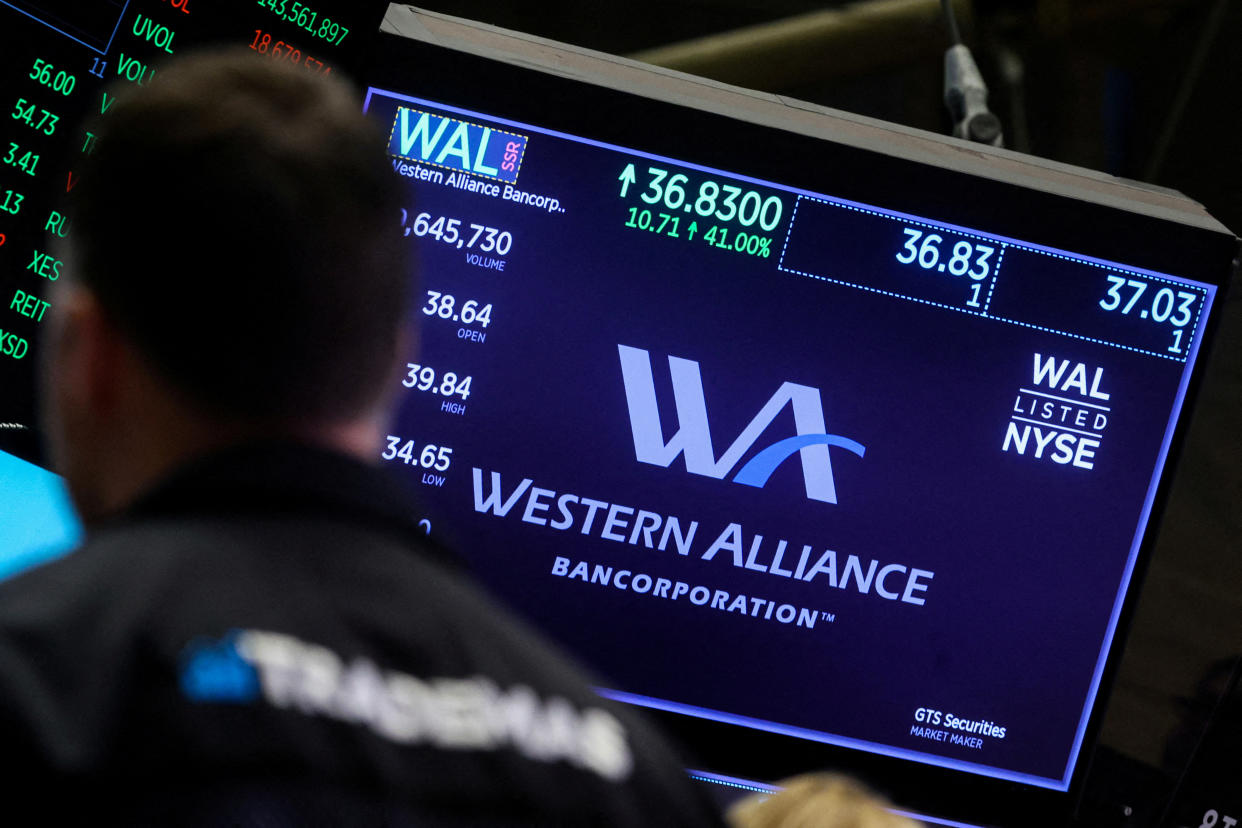Western Alliance stock pares some losses after reassuring investors about deposits
Western Alliance (WAL) stock fell on Wednesday, but pared some losses in afternoon trade, as the Phoenix-based lender released a second preview of first-quarter results to satisfy investors who wanted more clarity on deposit outflows.
Western Alliance began the day down as much as 17% after putting out a release late Tuesday showing that its percentage of deposits covered by the Federal Deposit Insurance Corporation was 68% at the end of the first quarter, "significantly higher" than at the end of 2022.
In a second update Wednesday afternoon the bank said deposits fell by $6 billion during the first quarter.
The stock was down closer to 10% near 2:20 p.m. ET following this second update for investors.
The market reaction highlighted the challenges facing regional banks as they prepare to release earnings reports following a month of chaos for the industry. Some banks, such as Los Angeles-based PacWest (PACW) and San Francisco-based First Republic (FRC), have put out certain information early in an attempt to demonstrate stability, but such efforts are not always rewarded by nervous investors looking for new signs of stress.
The message was clear: Western Alliance now is less dependent on funding from uninsured depositors who are considered a greater flight risk during periods of uncertainty.
Analysts and stockholders focused instead on what Western Alliance didn't disclose, which was exactly how many deposits left the bank during the panic triggered by the failures of Silicon Valley Bank and Signature Bank in early March.
Western Alliance said it did experience outflows during that critical period last month but that balances have stabilized, growing by $900 million from March 20 to the end of the month.
From the end of the quarter through April 4, another $1.2 billion in deposits were added.
Wedbush analysts said in a new note Wednesday published before the company's second update that they forecast deposits dropped 13%-17% in the first quarter, or $7 billion-$9 billion, a larger outflow than the $5 billion Wedbush previously estimated.
Western Alliance was one of many regional banks that came under intense scrutiny following the seizures of Silicon Valley Bank and Signature Bank on March 10 and March 12, the second- and third-largest bank failures in U.S. history. Western Alliance was the nation's 40th-largest bank at the end of 2022 with nearly $68 billion in assets. Shares of the bank have been roughly cut in half since the start of the year.
Small and mid-sized banks across the U.S. lost $196 billion in deposits during the week ending March 15, according to updated data released by the Federal Reserve last Friday.
Outflows stabilized the following week as regulators promised to protect all depositors and help regional banks access liquidity if needed. The 25 biggest banks, though, lost $90 billion in the week ending March 22.

Western Alliance offered up other points in its release Tuesday designed to calm investors.
The bank said it no longer had any borrowings outstanding from the Fed's discount window at the end of the first quarter, and unrealized losses on its bond portfolios had improved "primarily due to lower interest rates."
The value of long-term bonds held by many banks fell over the past year due to the Fed's aggressive campaign to bring down inflation by hiking rates.
The bank also said its "immediately available liquidity" exceeded uninsured deposits. A lack of liquidity in part sank Silicon Valley Bank after its depositors pulled $42 billion in a single day.
"Western Alliance's uniquely flexible, diversified business model positioned us to weather the liquidity tightness that enveloped the industry over the past month," said Western Alliance CEO Kenneth Vecchione.
Click here for the latest stock market news and in-depth analysis, including events that move stocks
Read the latest financial and business news from Yahoo Finance
